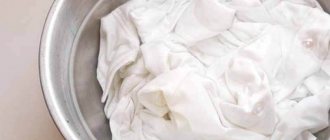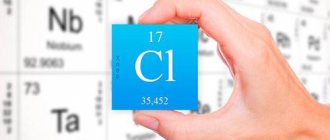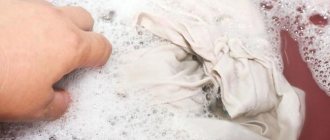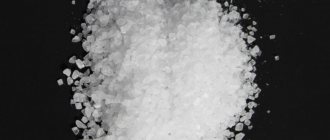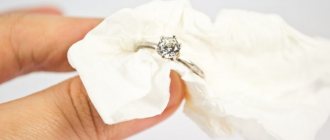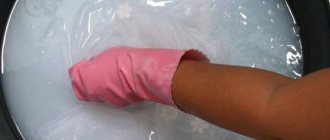Update date: 07/17/2020 15:13:23 6412 Share:
Author: Anastasia Berkovich
*Review of the best according to the editors of simplerule.ru. About the selection criteria. This material is subjective in nature, does not constitute advertising and does not serve as a purchase guide. Before purchasing, consultation with a specialist is required.
You can bleach laundry using hydrogen peroxide itself or with the addition of other products. Here's the basic way:
- Pour a bucket of warm water.
- Add hydrogen peroxide and mix well. For every liter of water you need to pour one teaspoon of the product.
- Place the laundry in the solution and leave for 20-30 minutes.
- Take the laundry out and run it under the tap for about a minute to rinse.
- Wring out the item and hang it to dry.
If stains remain on clothes after bleaching, they can be removed by combining hydrogen peroxide with baking soda. A solution of these two products helps to cope with stains no worse than factory stain removers. Follow these instructions exactly:
- Prepare a paste of baking soda and hydrogen peroxide. For 1 teaspoon of powder you will need 10 ml of product.
- Apply the mixture to the stains with a cotton pad and leave for 15 minutes.
- After processing, rinse the item well. The spots should disappear.
- Wring out the item and hang it to dry.
- If white curtains are not washed for a long time, they begin to turn gray under the influence of accumulating dust. To return them to their previous appearance:
- Pour 5 liters of warm water into a bucket or basin.
- Add a tablespoon of peroxide and a tablespoon of ammonia there.
- Soak the curtain in the solution and leave for half an hour.
- Rinse under running water.
- Wash your curtains as usual.
A solution of hydrogen peroxide, citric acid and soda ash will help deal with particularly difficult stains, such as greasy ones. Clean the item from excess contaminants and process as follows:
- Pour 2 liters of warm water into a bucket.
- Mix in it a teaspoon of hydrogen peroxide, a teaspoon of citric acid and a tablespoon of soda.
- Immerse your clothes in the resulting solution and leave for 15-20 minutes.
- Rub the stain. It should come off.
- Rinse the item thoroughly under water.
A mixture of hydrogen peroxide and dish soap also works well for oil and grease stains. This solution is easy to prepare and works well for cotton, but is not recommended for silk or wool:
- Pour 5 liters of warm water into a bucket.
- Add 2 tablespoons hydrogen peroxide and 1 tablespoon dish soap. Stir well.
- Immerse the laundry in the solution. Rub the stained area submerged in water to help the stain come off. Leave to soak for 15-20 minutes.
- After processing, rinse the item well. The spots should disappear.
- Wring out the item and hang it to dry.
You can also make your own stain remover using this recipe if there is no need to soak the entire item before washing. Simply mix peroxide and dish soap in the same ratio (the amount depends on how much solution you need). There are other recipes for hydrogen-based stain removers.
Traditional method - boiling
Our grandmothers used it when there were no automatic washing machines. Only cotton and linen fabrics are allowed to boil. It is advisable not to use this method for clothing.
We recommend bleaching the following items using boiling water:
- bed sheets;
- kitchen and bath towels;
- tablecloths;
- panties, bras;
- socks;
- baby rompers and diapers.
Only dishes with an enamel coating or stainless steel are suitable for bleaching. After boiling in galvanized aluminum buckets, reddish-brown stains may remain on the white.
For 1 kilogram of things take 10 liters of water. The procedure is as follows:
- Dissolve half a piece of laundry soap and 2 tablespoons of baking soda in a bowl of warm water. Soak white items for 3 hours.
- Remove the laundry and rinse thoroughly in clean water.
- Pour cold water into a large container and place the items that need to be bleached at the bottom. You can add a little ammonia or hydrogen peroxide, soap shavings.
- Turn on the burner.
- Bring the solution to a boil and then turn the heat to low. Boil things for 1-1.5 hours.
- Cool and rinse the laundry thoroughly.
A common mistake made by housewives is immersing white clothes in boiling water rather than cold. This causes the yellow stains to become “sealed” onto clothing and bedding.
Reviews
Good afternoon everyone! The other day I read on the Internet how to whiten your teeth and remove plaque, stones and all that at home in one session. In short, take half a teaspoon of soda, pour 15-20 drops of hydrogen peroxide into it and dip it into this mixture with a cotton swab and... rub it into your teeth. For better effect, add lemon juice. (this is for better breath smell) Read and done! I scrolled through everything as written. I rubbed the cotton wool on my fangs and then I felt the gag reflex begin! Hydrogen peroxide turned out to be so disgusting in taste, and even together with soda - complete bummer! I quickly rinsed my mouth and brushed my teeth with normal paste - everything seemed to go away. And in the morning I look, and my teeth are really like snow! So I advise you to try everything!
Maksim
It’s better not to experiment with your own teeth - baking soda and simple peroxide won’t do anything good to your teeth. For safer whitening, special formulations are created that contain stabilizers, medicinal substances and the actual active components based on peroxides. – science does not stand still – but strives for safe medicine!
Director
Do not whiten your teeth with peroxide and soda under any circumstances; it is better to buy a professional product or go to the dentist! A friend of mine decided to whiten her teeth on her own using baking soda and peroxide... After this procedure, tooth enamel became thin and her teeth were sensitive. Better yet, just eat strawberries
AnnaLee
Hydrogen peroxide and baking soda don't help me. Still, it’s better to go to professionals.
Mar5
I remove yellow plaque from my teeth with regular hydrogen peroxide.
MamaKati
zubneboley.ru
How to bleach laundry without boiling at home?
It is worth resorting to boiling laundry only when there are strong and old stains. This method is not suitable for frequent bleaching, as it leads to thinning and destruction of tissue.
Luckily, the store sells commercial bleaches in liquid and powder forms. Some are suitable for hand washing clothes in warm or cold water, others are suitable for automatic washing.
There are many home remedies that allow you to restore the whiteness of white things without boiling: soda, salt, ammonia, aspirin and others.
Peroxide based gels
Today on sale you can find special gels containing hydrogen peroxide and a special substance - urea, which, due to its properties, promotes the active production of oxygen when in contact with air.
Among the most common whitening gels are:
- White Perfect - this product is often used by professional dentists, which confirms that it meets all safety requirements.
- Brilliant is a gentle product, suitable for those with sensitive enamel.
- Teeth Whitening Pen - the product is available in the form of a pencil with a brush, which greatly facilitates the application process.
- White Light is a gel designed for use with mouth guards and a UV lamp. Those who decide to use this particular drug will have to take care of purchasing a lamp and cap.
The best way to whiten
There is no universal product that is suitable for bleaching all types of fabrics and items and removing all types of stains. The best method is the one that is selected for a specific case.
To make it easier for you to navigate whitening products, we suggest that you familiarize yourself with the table:
| Way | What fabrics is it suitable for? | What does it cope with? |
| Hydrogen peroxide | Cotton, wool | Returns whiteness to gray and yellowed items, removes traces of sweat, grease, and cosmetics |
| Aspirin | Linen, wool, synthetics, cotton | Fresh blood and sweat stains, gray coating |
| Aspirin | Cotton, synthetic | Fresh blood and sweat stains, gray coating |
| Salt | Cotton, synthetic | Cotton, synthetic |
| Potassium permangantsovka | Any | Removes traces of sweat, deodorant, and restores brightness to prints on white items |
| Mustard powder | Anything except silk | Gray coating, traces of fat, yellow spots |
| Citric acid, lemon juice | Cotton | Light soiling on clothing: yellow residue in the armpits and back |
| Chlorine bleaches: “Whiteness”, “Snow White” | Cotton, linen | Gray, yellow marks, blood |
| Oxygen-containing bleaches: “Soap nuts ECO 2”, “Persol Extra”, Oxygen | Any | Old yellow stains, fading of fabric, traces of grease, blood, red alcoholic drinks |
| Optical brighteners: Vanisn Gold, Heitmann | Cotton (you cannot wash clothes and baby items, as bleach particles remain in the fabrics), synthetics | Masks grayness and yellowness |
We recommend: Wash Converse and other fabric sneakers correctly
Now let’s look at each whitening method in more detail.
How to bleach things with soda and hydrogen peroxide?
At home, it is better to start whitening with folk remedies that every housewife has in her kitchen. They are safe for health and do not require large financial investments.
How to use baking soda?
- Fill a 10-liter bucket halfway with warm water and add 6 tablespoons of baking soda. Pour in a spoonful of ammonia and stir.
- Place clothes (bed linen) at the bottom of the bucket. Leave to soak for 2-5 hours depending on the degree of contamination.
- Rinse white items thoroughly and machine wash them at 60 degrees.
If the contamination is significant, use a 3% solution of hydrogen peroxide, which is sold in any pharmacy:
- Pour a tablespoon of solution into a 3-liter bowl of water.
- Soak white items for 30-60 minutes.
- Rinse thoroughly and dry. If the weather is sunny, hang your laundry outside.
Using hydrogen peroxide, you can remove individual stains on cotton. To do this, treat the yellow area with the solution and wait 5 minutes. Gently scrub the fabric with a bar of soap and rinse with water.
Contraindications
Before using hydrogen peroxide for teeth whitening, you should pay attention to the fact that this product has a large number of contraindications. The most common contraindications include the following:
- Having an allergy to hydrogen peroxide;
- Application of bracket systems;
- If there are malignant formations in the oral cavity;
- Bleaching is not recommended if there is open pulp. Otherwise, soft tissue burns may occur;
- Caries or if there are many teeth with fillings;
- Dental diseases in which periodontal damage is observed - periodontitis and periodontal disease;
- Congenital diseases in which there is an increased degree of enamel thinness;
- Do not use if you are hypersensitive to temperature changes;
- Diseases of the oral cavity in chronic and acute form;
- During pregnancy or breastfeeding.
Using aspirin to lighten tissue
A white T-shirt (shirt) has a gray tint due to frequent washing, but you don’t want to ruin your favorite item by bleaching it? Choose gentle methods, which include aspirin. The active ingredient is acetylsalicylic acid. It penetrates deep into the tissue, removes residual powders and concentrates.
How to use aspirin for whitening?
- Crush 5 tablets into powder. Dissolve in two liters of hot water.
- Soak a white T-shirt or shirt in the solution overnight.
- In the morning, wash the item by hand with regular soap or put it in a washing machine. You can add 2-3 more aspirin tablets to the washing powder. By the way, this method is suitable for preventing fabric tarnishing.
- Shake and leave the item to dry.
The cheapest way is salt
Most often, salt is used to prevent yellowing of bed linen and kitchen towels: once a month, before washing, white items are soaked for 2 hours in a solution of warm water with the addition of 2-3 tablespoons of salt.
If you need to bleach grayed items, salt is used in combination with hydrogen peroxide, baking soda, ammonia or boric acid. Sodium chloride enhances the effect of these bleaches.
The procedure is as follows:
- Add 3 tablespoons of salt and hydrogen peroxide, a teaspoon of ammonia and a little washing powder to a bowl of hot water.
- Place items in a basin for 2 hours and then wash.
- Rinse and leave to dry.
We return the whiteness to yellowed laundry
After many washes, light-colored fabric can acquire a gray, yellow, or light green tint. There are several reasons for this negative impact:
- Washing water with a high iron content (more than 7 degrees of hardness), nitrates.
- The use of washing powders, stain removers with a high content of phosphates, flatates, and hydrochloric acid.
- Regularly wash light-colored bed linen with dark-colored items.
Folk methods that use gentle detergents will help restore a presentable appearance to products. In addition to the loss of natural shine and color, stains of various origins appear on the fabric.
Delicate whitening – potassium permanganate
Use this method if you want to return sparkling whiteness to silk blouses and dresses. Potassium permanganate acts gently and does not destroy delicate tissue. True, it will not help get rid of old stains.
- Prepare a solution of 10 liters of water, half of baby soap and 4 crystals of potassium permanganate.
- Soak the item for 6-8 hours.
- Rinse and dry.
Use of mustard powder
Mustard is the best home remedy for removing grease stains from white clothes. Housewives use mustard powder to care for cotton tablecloths, towels, and kitchen curtains.
The procedure is as follows:
- Dissolve a bag of mustard powder in 5 liters of hot water.
- Leave things in the solution for 3 hours.
- Rinse with clean water to remove any traces of mustard and place in the washing machine.
- Dry white items.
Preparing for washing
To ensure that the laundry becomes white and all stains are removed from the fabric, you need to prepare things for washing. It is better to do this by soaking them first. Pour warm water into a wide basin, add washing powder, bleach (if the fabric allows) and place the laundry. Leave the items to soak for 4-5 hours, and then proceed to washing.
If you plan to use a certain bleaching product, do not be lazy and test its effect on an inconspicuous area or a separate piece of the same fabric so as not to spoil the laundry.
Citric acid and lemon juice
These products perfectly remove gray and yellow plaque, but are harsh, so they are only suitable for cotton fabrics. Also, using citric acid, remove stains on shoes: sneakers, textile ballet shoes.
- Dissolve 10 tablespoons of citric acid or juice from two citrus fruits in a 10-liter bucket of hot water.
- Soak white items for 5-6 hours.
- Rinse and leave to dry.
We recommend: Is it possible to wash oilcloth in a washing machine: options for different materials
Chlorine bleaches
In the past, our mothers and grandmothers often used the industrial chlorine product “Belizna” for bleaching. And now it can be found on sale in liquid or powder form. It costs mere pennies, but it perfectly removes grayish plaque and any old stains, including those from sweat, grease, blood, wine, and grass.
But “Whiteness” also has a number of significant shortcomings.
- not suitable for wool, delicate fabrics, synthetics, white items with bright patterns;
- with frequent use it leads to thinning of the fabric, the formation of holes, abrasions, and yellow stains;
- causes allergic skin reactions in some people;
- It smells bad;
- Chlorine vapors are unsafe for the respiratory system and irritate the mucous membranes of the eyes.
Use chlorine bleach only with rubber gloves. You should try not to inhale the smell, and after treating white things, ventilate the apartment.
How to whiten white things using “Whiteness”?
- Soak the laundry in water and soap (half a piece) for 2 hours.
- Wash by hand.
- Pour cold water into a 3-liter basin. Add a tablespoon of bleach.
- Pour the resulting liquid into a container with white things. Leave for 15-20 minutes.
- Rinse and dry the laundry thoroughly.
Chlorine reacts with metals and can damage your washing machine. Although some manufacturers leave the “Automatic” mark on product packaging, it’s not worth the risk. Wash white items with “White” by hand.
Precautions when working with the substance
There are certain precautions when working with peroxide to avoid tissue damage:
- The soda mixture with peroxide is applied to the fabric for no more than 5 minutes.
- Do not soak delicate materials in hot water with peroxide.
- To enhance whitening, do not add commercial bleaches.
- Do not remove rust stains with peroxide to avoid ruining your clothes.
- Use only 3% product, 10% concentrate and higher - cause skin corrosion. In case of contact with skin, rinse immediately with plenty of water. If swelling and hyperemia persist, you should consult a doctor.
- Avoid splashing peroxide on mucous membranes, mouth and eyes to avoid chemical burns.
- Wash with rubber gloves in a ventilated area.
By following these recommendations, you will avoid unpleasant consequences of work. To avoid spoiling the material, try the folk remedy on a small area.
Blog author. Experience in the field of cleaning services - 11 years. I love cleanliness and order in all areas of life. Beloved wife, mother of 3 children and attentive housewife. I have tried in my practice all the methods listed on the site. glad to meet you

